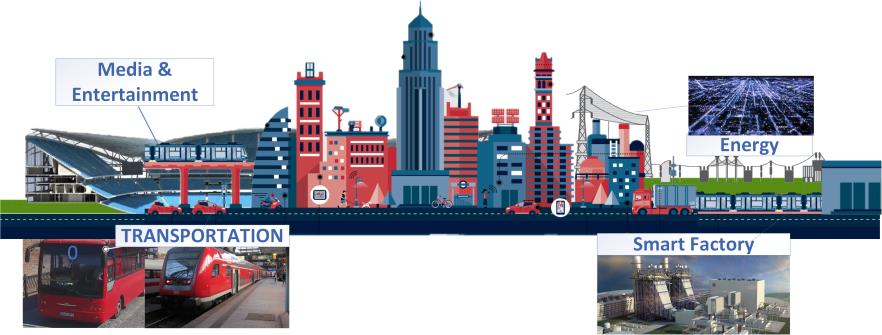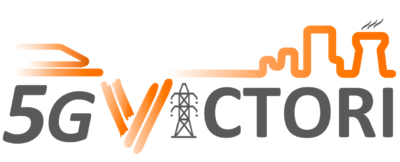Motivation
Digital technologies have been identified by the EU as key in addressing some of its fundamental challenges associated with societal and economic objectives, such as improved quality of living for citizens, sustainable development and economic growth. This approach, also referred to as the Fourth Industrial Revolution, is becoming a reality for millions of people around the world creating new opportunities for governments, businesses and individuals. In this context, telecommunication networks will play a fundamental role in bringing these technologies to society, organizations and countries transforming their every day’s life in the way services are provided, and businesses as well as governments are run. The effect of this approach is expected to influence a large variety of sectors through the ability to offer connected goods, collaborative and automated processes within and across sectors, optimized processes with regards to energy or other resource consumption, optimized transportation and logistics, new and improved services with regards to safety and security, user experience etc. Some of the sectors, also known as vertical to the ICT industry, that will be clearly influenced and benefited by this approach among others include:
Transportation
Energy
Media
Factories of the future
However, this transformation will require new service capabilities that network operators need to support including:
i) connectivity for a growing number of very diverse devices,
ii) ubiquitous access with varying degrees of mobility from low to high in heterogeneous environments and,
iii) mission critical services currently handled by closed specific purpose networks [5G-PPP], supporting highly variable performance attributes in a cost and energy-efficient manner.
Typical examples include networks used to provide operational services in mobile telecommunication networks, vertical industries such as communication networks used by railway operators, energy metering, smart factories, media services, etc. These demanding and diverse requirements cannot be supported by current 4G solutions and best effort internet connections or even a smooth migration from existing network architectures and technology deployments to next generation solutions. Instead, it requires a paradigm shift to support the upcoming service requests imposing enormous capacity requirements that exceed 1000 times current bandwidth needs, available to 10s of billions of end-devices fixed and mobile devices, following new service models such as cloud-based solutions [5G-PPP]. Only future proof infrastructures adopting flexible architectures offering converged services across heterogeneous technology domains deploying unified software control will be able to address a wide range of vertical industry services. In response to these needs, 5G platforms can play an instrumental role in bringing together technology players, vendors, operators and verticals orchestrating their interaction with the aim to open up new business models and opportunites for the ICT and vertical industries and also enable cross-vertical collaborations and synergies to offer further enhancement in value propositions. As 5G targets to support a set of stringent requirements in terms of latency (below 5 ms), reliability and density (up to 100 devices/m2), along with tight constraints on geographical and population coverage and high speed mobility capabilities (exceeding in some cases 500 km/h), it is clear that it can provide the most suitable framework in support of the greatly varying strict requirements of vertical industries. In view of this, it is expected that 5G can facilitate the cost levels required to meet the vertical customers’ expectations and needs, satisfying at the same time the guaranteed level of Quality of Service (QoS) expected by end-users and the sustainability objectives demanded by society. A significant part of this interaction includes identification and definition of vertical industry requirements that will be translated into technical specifications with the aim to drive technical developments in support of the vertical service offerings and cross-vertical collaborations.

As deploying 5G solutions for vertical industries in Europe is a well-defined objective, there is a clear need to develop future proof 5G infrastructures to address a wide range of vertical applications adopting a flexible architecture, offering converged services across heterogeneous technology domains deploying unified software control. It is true to say that despite the European strategy to support verticals through 5G solutions, verticals face the problem that they can only practically verify their use cases in small scales in commercially relevant environments before investing in large scale deployments. Through ICT-17 projects, EU has invested in the development of 5G ICT infrastructures that will become available to verticals to test their applications. ICT-17 projects provide small scale testbed infrastructures that in some cases need suitable extensions to enable integration of verticals and allow a small scale testing environment for vertical commercially relevant infrastructures. However, large scale trials are not possible with the current ICT-17 facilities. In view of this, 5G-VICTORI aims at conducting large scale trials for advanced use case verification in a commercially relevant 5G environment for a number of verticals including Transportation, Energy, Media and Factories of the Future as well as some specific use cases involving cross-vertical interaction (Figure 1). The specific use cases that 5G VICTORI will concentrate on include:
- “Enhanced Mobile broadband under high speed mobility”, Vertical: Transportation – Rail,
- “Digital Mobility”, Cross-Vertical – Transportation and Media,
- “Critical services for railway systems”, Vertical: Rail,
- “Smart Energy Metering”, Cross-Vertical: Energy and Rail,
- “Digitization of Power Plants”, Vertical: Smart Factory, and
- “CDN services in dense, static and mobile environments”, Vertical: Media




